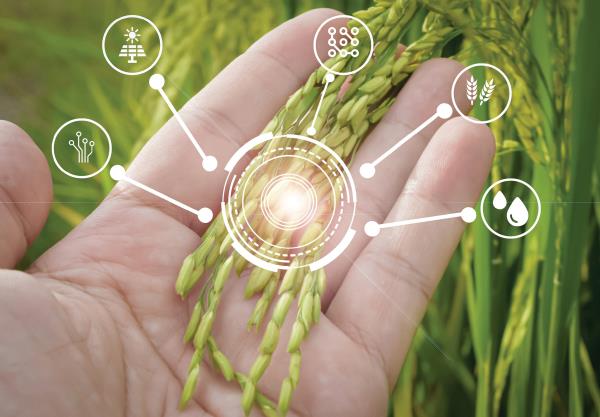10 March 2022

Farming is one of the oldest industries in the history of humankind. Chris Mason, VP of sales, EMEA for Rajant Corporation, explains what modern farmers need to
Over the last 50 years, there has been a rapid increase in the world’s population and it continues to expand faster than any other time in human history. For small farmers, herders, and fishermen, who currently produce about 70% of the global food supply, this presents a huge task. Agricultural operations worldwide face mounting pressure to feed an ever-increasing populace, meet stringent sustainability regulations, and overcome a myriad of other modern challenges, all while conserving both farmland and water due to a diminishing natural resource base.
The need to overcome these modern challenges in fast-paced farming environments has never been higher – and the answer lies with precision farming. The global precision farming market is anticipated to reach US$10.23bn by 2025. Still, for it to achieve optimum success, the agriculture industry needs to introduce a network that can make precision farming a reality.

Today’s agricultural pressures
The predominant challenge faced by the agricultural industry is finding a solution that creates as much yield as possible while using as few resources as possible. In today’s digital age, many industries are embracing technology more than ever to increase efficiency and overcome challenges. By leveraging the Industrial Internet of Things (IIoT) or Industry 4.0 technologies, modern farmers can harness the power of automation to establish precision farming practices.
Precision farming relies upon IIoT devices and other automated equipment to increase efficiency while remaining sustainable. As the devices require minimum human intervention, they can work day and night to produce a higher yield. Many agricultural industry leaders have already begun embracing this new way of working and the best way of integrating IIoT into agricultural operations is by deploying applications that can drive significant productivity gains to stimulate growth. This approach will ultimately increase precision, reduce waste, and maximize yield. However, farmers need a network that can quickly grow to support more and new IIoT-enabled assets, with increasingly autonomous demands, over time.
The evolution of precision farming
Automation encompasses a broad spectrum of capabilities, making it an accessible option for any size or background of farming operations. With so many different types of IIoT equipment available on the market, it has become easier than ever before to take that first step into precision farming.
For beginners, static and semi-autonomous machinery are excellent options as they are simple to install and have an optimal effect on operations and productivity levels. For example, upgrading tractors with GPS, built-in sensors, and variable-rate technology (VRT) allows the farming vehicles to navigate fields autonomously and work together to till, seed, and plant, ensuring that no arable land or resources are wasted.
For more advanced farms, 100% autonomy is only a stone’s throw away. In Japan, a vegetable production operation has gone entirely automated. Production of lettuce and other vegetables is stacked to take up less land, and everything from planting, to watering, to pruning, to harvesting is done by autonomous machinery. The United Kingdom is also investigating autonomous farming with an experimental research farm recently harvesting its first fully automated crop, reaping close to five tons of spring barley.
Navigating networking obstacles
Automated precision farming techniques offer a universal answer to many of the agriculture industry’s challenges. However, for some areas, the transition to precision farming is far from straightforward. There are several obstacles that keep traditional farms from adopting automation or relegate them to a low level of automation without the ability to scale their operations.
The main barrier to automation is the lack of connectivity. Farms are typically located in remote, rural areas that lack a strong signal. Equally, in an agricultural environment, networking and automation equipment must withstand extreme temperatures, countless weather events, and harmful chemical sprays. In fact, for those reasons, many farmers view autonomous equipment as a liability rather than an investment. The layout of farms is also limiting, as there is a vast amount of land to cover. Silos, buildings, and heavy machinery can also create signal reflection and refraction, which interrupts communications.
Farms need a network that can overcome these common obstacles to successfully utilize autonomous precision farming applications and enable the IIoT at varying levels. That makes installing a network that addresses these challenges a top priority for farming operations that wish to move up the levels of autonomy and best farming practices.

Achieving agricultural automation
High bandwidth to support the streaming of massive amounts of data and video collected from different sensors and monitoring applications are needed for fully autonomous farms to work effectively. Robust connectivity must also be maintained within a network topology that is shifting from second to second.
Rajant’s Living Network solution, powered by a fully mobile and ruggedised private wireless network known as Kinetic Mesh, integrates with legacy infrastructure to drive precision farming automation at every level. Rajant’s Kinetic Mesh network becomes more valuable as automation becomes more complex, as it can scale to support increasingly automated operations seamlessly. No matter where a farming operation begins or which level of automation it wishes to achieve, Rajant powers better, more dynamic connectivity than traditional network alternatives.
Equally, it is not only reliable connectivity that Rajant provides. Rajant BreadCrumb nodes are built to withstand the harshest conditions and extreme environments while remaining easy to deploy. So even in the harshest elements, farmers can be confident their network will work effectively. Rajant’s Kinetic Mesh network is proven to work effectively in the agriculture industry. The network was successfully utilised at a 480,000+ hectare palm oil plantation spread across remote islands and locations with minimal cellular coverage. Also, it has been deployed to power forest-wide remote monitoring and operational optimization applications at a large eucalyptus farm. Using Rajant’s technology, the farm monitored tree growth pace, identified diseases, and improved disaster management.
Making the future of farming possible
No matter the level of automation a farm begins at, precision farming techniques and IIoT devices can be used to overcome today’s challenges and make operations more accurate, efficient, and scalable. Solutions that allow digital seeding and fields to be harvested can be used to help meet growing food demands. Planting precisely to utilize every available inch of existing farmland, to avoid further deforestation is simpler. Precision farming will ultimately not only help farmers but, in turn, the population and the planet.
Rajant’s Kinetic Mesh technology can move with farm operations to drive IIoT capabilities and enable highly-mobile, highly-secure precision farming practices for any level of automation. With the help of Rajant, farmers can overcome today’s challenges to optimize their operations and harvest their full potential.







